

Book of Caverns. Fifth division: A scene from tomb of Ramses V.
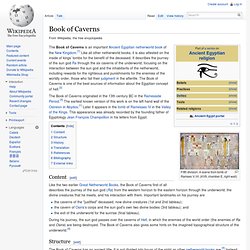
/VI. (KV9, chamber E, right wall) The Book of Caverns is an important Ancient Egyptian netherworld book of the New Kingdom.[1] Like all other netherworld books, it is also attested on the inside of kings’ tombs for the benefit of the deceased. Book of the Earth. Fifth division: A scene from "Book of Caverns" from the tomb of Ramses V.
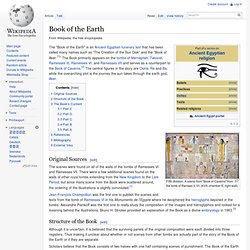
/VI. (KV9, chamber E, right wall) Original Sources[edit] The scenes were found on all of the walls of the tombs of Ramesses VI and Ramesses VII. There were a few additional scenes found on the walls of other royal tombs extending from the New Kingdom to the Late Period, but since many scene from the Book were scattered around, the ordering of the illustrations is slightly convoluted.[1] Jean-François Champollion was the first one to publish the scenes and texts from the tomb of Ramesses VI in his Monuments de l'Egypte where he deciphered the hieroglyphs depicted in the tombs. Structure of the Book[edit] Although it is uncertain, it is believed that the surviving panels of the original composition were each divided into three registers.
Book of Gates. Another rendering.
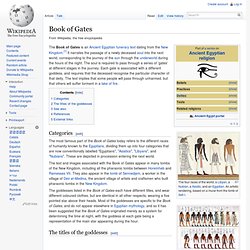
Categories[edit] The most famous part of the Book of Gates today refers to the different races of humanity known to the Egyptians, dividing them up into four categories that are now conventionally labelled "Egyptians", "Asiatics", "Libyans", and "Nubians". These are depicted in procession entering the next world. The text and images associated with the Book of Gates appear in many tombs of the New Kingdom, including all the pharaonic tombs between Horemheb and Ramesses VII. They also appear in the tomb of Sennedjem, a worker in the village of Deir el-Medina, the ancient village of artists and craftsmen who built pharaonic tombs in the New Kingdom. The goddesses listed in the Book of Gates each have different titles, and wear different coloured clothes, but are identical in all other respects, wearing a five pointed star above their heads.
Book of the Dead. This detail scene, from the Papyrus of Hunefer (ca. 1275 BCE), shows the scribe Hunefer's heart being weighed on the scale of Maat against the feather of truth, by the jackal-headed Anubis.
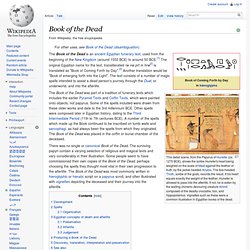
The ibis-headed Thoth, scribe of the gods, records the result. If his heart equals exactly the weight of the feather, Hunefer is allowed to pass into the afterlife. If not, he is eaten by the waiting chimeric devouring creature Ammit composed of the deadly crocodile, lion, and hippopotamus. Vignettes such as these were a common illustration in Egyptian books of the dead. The Book of the Dead is an ancient Egyptian funerary text, used from the beginning of the New Kingdom (around 1550 BCE) to around 50 BCE.[1] The original Egyptian name for the text, transliterated rw nw prt m hrw[2] is translated as "Book of Coming Forth by Day".[3] Another translation would be "Book of emerging forth into the Light". Development[edit] In the Middle Kingdom, a new funerary text emerged, the Coffin Texts. Spells[edit] Book of the Netherworld. The Enigmatic Book of the Netherworld is a two-part ancient Egyptian funerary text found on the second shrine in KV62, the tomb of the pharaoh Tutankhamun.
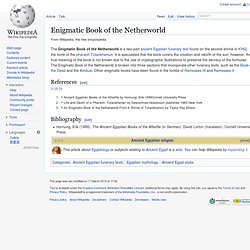
It is speculated that the book covers the creation and rebirth of the sun; however, the true meaning of the book is not known due to the use of cryptographic illustrations to preserve the secrecy of the formulae. The Enigmatic Book of the Netherworld is broken into three sections that incorporate other funerary texts, such as the Book of the Dead and the Amduat. Other enigmatic books have been found in the tombs of Ramesses IX and Ramesses V. References[edit] Jump up ^ Ancient Egyptian Books of the Afterlife by Hornung, Erik 1999Cornell University PressJump up ^ Life and Death of a Pharaoh: Tutankhamen by Desrochnes-Noblecourt published 1963 New YorkJump up ^ An Enigmatic Book of the Netherworld From A Shrine of Tutankhamun by Taylor Ray Ellison Bibliography[edit] Hornung, Erik (1999).